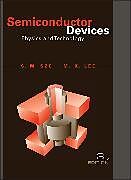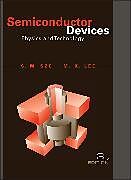Semiconductor Devices
Einband:
Fester Einband
EAN:
9780470537947
Genre:
Electrical Engineering
Autor:
Simon M. Sze, Lee Ming-Kwei
Herausgeber:
John Wiley & Sons
Erscheinungsdatum:
30.12.2016
"Semiconductor Devices: Physics and Technology, Third Edition is an introduction to the physical principles of modern semiconductor devices and their advanced fabrication technology. It begins with a brief historical review of major devices and key technologies and is then divided into three sections: semiconductor material properties, physics of semiconductor devices and processing technology to fabricate these semiconductor devices"--
Autorentext
S. M. Sze, PhD, is UMC Chair Professor in the Electronics Engineering Department at the National Chiao Tung University. His previous books include Semiconductor Devices; Physics of Semiconductor Devices, Second Edition; High-Speed Semiconductor Devices; and Semiconductor Sensors, all available from Wiley. Ming-Kwei Lee, Professor, Department of Electrical Engineering, National Sun Yat-sen University, Kaohsiung, Taiwan.
Klappentext
Semiconductor Devices: Physics and Technology, 3rd Edition The awaited revision of Semiconductor Devices: Physics and Technology offers more than 50% new or revised material that reflects a multitude of important discoveries and advances in device physics and integrated circuit processing. Offering a basic introduction to physical principles of modern semiconductor devices and their advanced fabrication technology, the third edition presents students with theoretical and practical aspects of every step in device characterizations and fabrication, with an emphasis on integrated circuits. Divided into three parts, this text covers the basic properties of semiconductor materials, emphasizing silicon and gallium arsenide; the physics and characteristics of semiconductor devices bipolar, unipolar special microwave and photonic devices; and the latest processing technologies, from crystal growth to lithographic pattern transfer.
Zusammenfassung
* Covers all key semiconductor devices with up-to-date information and easy-to-understand descriptions. Each chapter is presented in a logical manner enabling students to learn all important devices from a single source. * Covers historical developments of devices and technology in the last 100 years.
Inhalt
Preface vii Acknowledgments ix Chapter 0 Introduction 1 0.1 Semiconductor Devices 1 0.2 Semiconductor Technology 6 Summary 12 PART I SEMICONDUCTOR PHYSICS Chapter 1 Energy Bands and Carrier Concentration in Thermal Equilibrium 15 1.1 Semiconductor Materials 15 1.2 Basic Crystal Structures 17 1.3 Valence Bonds 22 1.4 Energy Bands 23 1.5 Intrinsic Carrier Concentration 29 1.6 Donors and Acceptors 34 Summary 40 Chapter 2 Carrier Transport Phenomena 43 2.1 Carrier Drift 43 2.2 Carrier Diffusion 53 2.3 Generation and Recombination Processes 56 2.4 Continuity Equation 62 2.5 Thermionic Emission Process 68 2.6 Tunneling Process 69 2.7 Space-Charge Effect 71 2.8 High-Field Effects 73 Summary 77 PART II SEMICONDUCTOR DEVICES Chapter 3 p-n Junction 82 3.1 Thermal Equilibrium Condition 83 3.2 Depletion Region 87 3.3 Depletion Capacitance 95 3.4 Current-Voltage Characteristics 99 3.5 Charge Storage and Transient Behavior 108 3.6 Junction Breakdown 111 3.7 Heterojunction 117 Summary 120 Chapter 4 Bipolar Transistors and Related Devices 123 4.1 Transistor Action 124 4.2 Static Characteristics of Bipolar Transistors 129 4.3 Frequency Response and Switching of Bipolar Transistors 137 4.4 Nonideal Effects 142 4.5 Heterojunction Bipolar Transistors 146 4.6 Thyristors and Related Power Devices 149 Summary 155 Chapter 5 MOS Capacitor and MOSFET 160 5.1 Ideal MOS Capacitor 160 5.2 SiO2-Si MOS Capacitor 169 5.3 Carrier Transport in MOS Capacitors 174 5.4 Charge-Coupled Devices 177 5.5 MOSFET Fundamentals 180 Summary 192 Chapter 6 Advanced MOSFET and Related Devices 195 6.1 MOSFET Scaling 195 6.2 CMOS and BiCMOS 205 6.3 MOSFET on Insulator 210 6.4 MOS Memory Structures 214 6.5 Power MOSFET 223 Summary 224 Chapter 7 MESFET and Related Devices 228 7.1 Metal-Semiconductor Contacts 229 7.2 MESFET 240 7.3 MODFET 249 Summary 255 Chapter 8 Microwave Diodes; Quantum-Effect and Hot-Electron Devices 258 8.1 Microwave Frequency Bands 259 8.2 Tunnel Diode 260 8.3 IMPATT Diode 260 8.4 Transferred-Electron Devices 265 8.5 Quantum-Effect Devices 269 8.6 Hot-Electron Devices 274 Summary 277 Chapter 9 Light Emitting Diodes and Lasers 280 9.1 Radiative Transitions and Optical Absorption 280 9.2 Light-Emitting Diodes 286 9.3 Various Light-Emitting Diodes 291 9.4 Semiconductor Lasers 302 Summary 319 Chapter 10 Photodetectors and Solar Cells 323 10.1 Photodetectors 323 10.2 Solar Cells 336 10.3 Silicon and Compound-Semiconductor Solar Cells 343 10.4 Third-Generation Solar Cells 348 10.5 Optical Concentration 352 Summary 352 PART III SEMICONDUCTOR TECHNOLOGY Chapter 11 Crystal Growth and Epitaxy 357 11.1 Silicon Crystal Growth from the Melt 357 11.2 Silicon Float-Zone Proces 363 11.3 GaAs Grystal-Growth Techniques 367 11.4 Material Characterization 370 11.5 Epitaxial-Growth Techniques 377 11.6 Structures and Defects in Epitaxial Layers 384 Summary 388 Chapter 12 Film Formation 392 12.1 Thermal Oxidation 392 12.2 Chemical Vapor Deposition of Dielectrics 400 12.3 Chemical Vapor Deposition of Polysilicon 409 12.4 Atom Layer Deposition 412 12.5 Metallization 414 Summary 425 Chapter 13 Lithography and Etching 428 13.1 Optical Lithography 428 13.2 Next-Generation Lithographic Methods 441 13.3 Wet Chemical Etching 447 13.4 Dry Etching 450 Summary 462 Chapter 14 Impurity Doping 466 14.1 Basic Diffusion Process 467 14.2 Extrinsic Diffusion 476 14.3 Diffusion-Related Processes 480 14.4 Range of Implanted Ions 483 14.5 Implant Damage and Annealing 490 14.6 Implantation-Related Processes 495 Summary 501 Chapter 15 Integrated Devices 505 15.1 Passive Components 507 15.2 Bipolar Technology 511 15.3 MOSFET Technology 516 15.4 MESFET Technology 529 15.5 Challenges for Nanoelectronics 532 Summary 537 APPENDIX A List of Symbols 541 APPENDIX B International Systems of Units (SI Units) 543 APPENDIX C Unit Prefixes 544 APPENDIX D Greek Alphabet 545 APPENDIX E Physical Constants 546 APPENDIX F Properties of Important Element and Binary Compound Semiconductors at 300 K 547 APPENDIX G Properties of Si and GaAs at 300 K 548 APPENDIX H Derivation of the Density of States in a Semiconductor 549 APPENDIX I Derivation of Recombination Rate for Indirect Recombination 553 APPENDIX J Calculation of the Transmission Coefficient for a Symmetric Resonant-Tunneling Diode 555 APPENDIX K Basic Kinetic Theory of Gases 557 APPENDIX L Answers to Selected Problems 559 Photo Credits 563 Index 565

Leider konnten wir für diesen Artikel keine Preise ermitteln ...
billigbuch.ch sucht jetzt für Sie die besten Angebote ...
Die aktuellen Verkaufspreise von 6 Onlineshops werden in Realtime abgefragt.
Sie können das gewünschte Produkt anschliessend direkt beim Anbieter Ihrer Wahl bestellen.
Loading...
Die aktuellen Verkaufspreise von 6 Onlineshops werden in Realtime abgefragt.
Sie können das gewünschte Produkt anschliessend direkt beim Anbieter Ihrer Wahl bestellen.
| # | Onlineshop | Preis CHF | Versand CHF | Total CHF | ||
|---|---|---|---|---|---|---|
| 1 | Seller | 0.00 | 0.00 | 0.00 |
